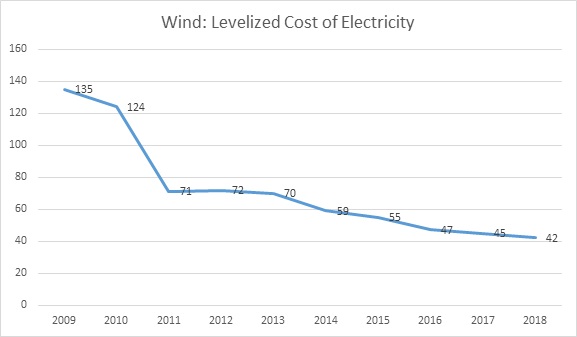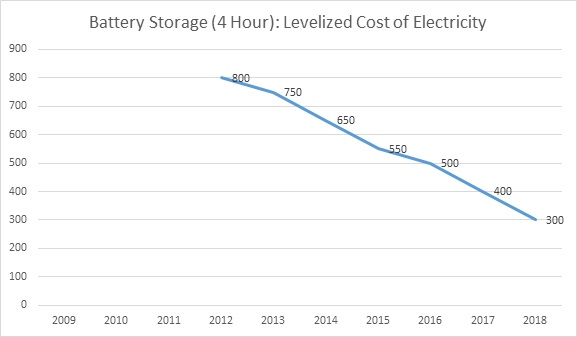by Michael Arny and Mary Reames — For years, the common perception has been that there were two main barriers to using renewable energy sources to power commercial buildings. Barrier 1 was the cost of renewable energy, either in the form of equipment and costs for on-site production or in higher rates to a utility providing an off-site renewables option. This barrier is being crushed by the ongoing reductions in the cost of renewable energy. Barrier 2 was the intermittent nature of most renewable energy sources, which doesn’t always match up with the patterns of commercial building loads. This barrier, too, is in the process of collapsing, due to the ongoing reductions in the cost of battery storage for renewable electricity on and off the electric grid. Public policy in various countries around the world, global markets, global production capacity, and ongoing advances in these technologies are all working together to driving cost down of wind energy production, photovoltaic electricity production and electric batteries.
Removing barrier 1: The decreasing costs of renewable energy
Recently, there has been a shift in perspective from natural gas use to electricity from renewable sources as the key emissions-reduction strategy for commercial buildings. In the 1990s, owners and managers of all-electric buildings were viewed with sympathy because they could not access the lower costs, and lower emissions, of natural gas. Now, owning or managing an all-electric building is an advantage, as electricity can be obtained directly from renewable sources or offset with the purchase of renewable energy credits (RECs). What was seen as a challenge is now being rediscovered as an opportunity. The cause of the change in opinion about all-electric buildings is the continuing reduction in the cost of renewable energy, particularly wind (Figure 1) and solar photovoltaics (PVs) (Figure 2).

Figure 1: Unsubsidized Wind Electricity: Levelized Cost of Electricity in the U.S., 2009-2018
(Average Cost per MWh over Life of Wind System) (LCOE)
Source for Figure 1: https://www.lazard.com/perspective/lcoe2019

Figure 2: Unsubsidized Photovoltaic (PV) Electricity: Levelized Cost of Electricity in the U.S., 2009-2018
(Average Cost per MWh over Life of PV System)
Source for Figure 2: https://www.lazard.com/perspective/lcoe2019
Removing barrier 2: Batteries for the electric grid and for buildings
The sun does not always shine, and the wind does not always blow. These facts of life, without intervention, lead to intermittency in the creation and transmission of wind and solar energy. Intervention in the form of battery storage is rapidly advancing to resolve this problem, however (Figure 3). Batteries can be used to resolve intermittency problems at the grid level by the utilities because of the ongoing reductions in the cost of electric batteries. In turn, building managers can take advantage of cost savings opportunities in power supply purchase that arise from ongoing reductions in renewable energy costs and as well as using electric storage batteries to reduce utility bills.
There are a variety of ways buildings can use on-site electric storage capacity to reduce electricity bills. One way is to reduce utility electricity demand charges for electricity use during peak periods, which range from time-of-use rates to annual peak demand charges. Batteries can be used to reduce energy use during these peak periods and thereby reduce utility bills. Another is for buildings to use storage to enhance their participation in utility load-shedding programs (demand response programs), for which utilities will provide some type of financial benefit (the type of benefit will vary depending on the utility).

Figure 3: Levelized Cost of Battery Storage Capacity (4 Hour) in the U.S., 2012-2018
(Average Cost per MWh of Storage Capacity over the Life of the Battery)
Source for Figure 3: https://about.bnef.com/blog/battery-powers-latest-plunge-costs-threatens-coal-gas/
What does this mean for building owners and managers?
Here are a few takeaways that building management should keep in mind as the costs of renewable energy decrease:
- Don’t give credence to the suggestion the intermittent nature of most types of renewable energy will be an ongoing barrier to high percentages of on grid and off grid electricity supply. Battery storage is not a future development, but is a practical option available for use right now.
- Keep your eye on potential cost savings opportunities in power supply purchase that arise from ongoing reductions in renewable energy costs. Possible paths include on-site renewables (in the form of owned systems or Power Purchase Agreements) and off-site renewables (in the form of direct purchase from your utility or, for offsetting your emissions, renewable energy credits and carbon offsets).
- Also keep your eye on potential cost savings opportunities in peak shaving/demand reduction that arise from ongoing reductions in battery costs. Possible paths include incorporating batteries in your on-site renewables array and off-site batteries utilized by utilities to smooth the transition to renewables.